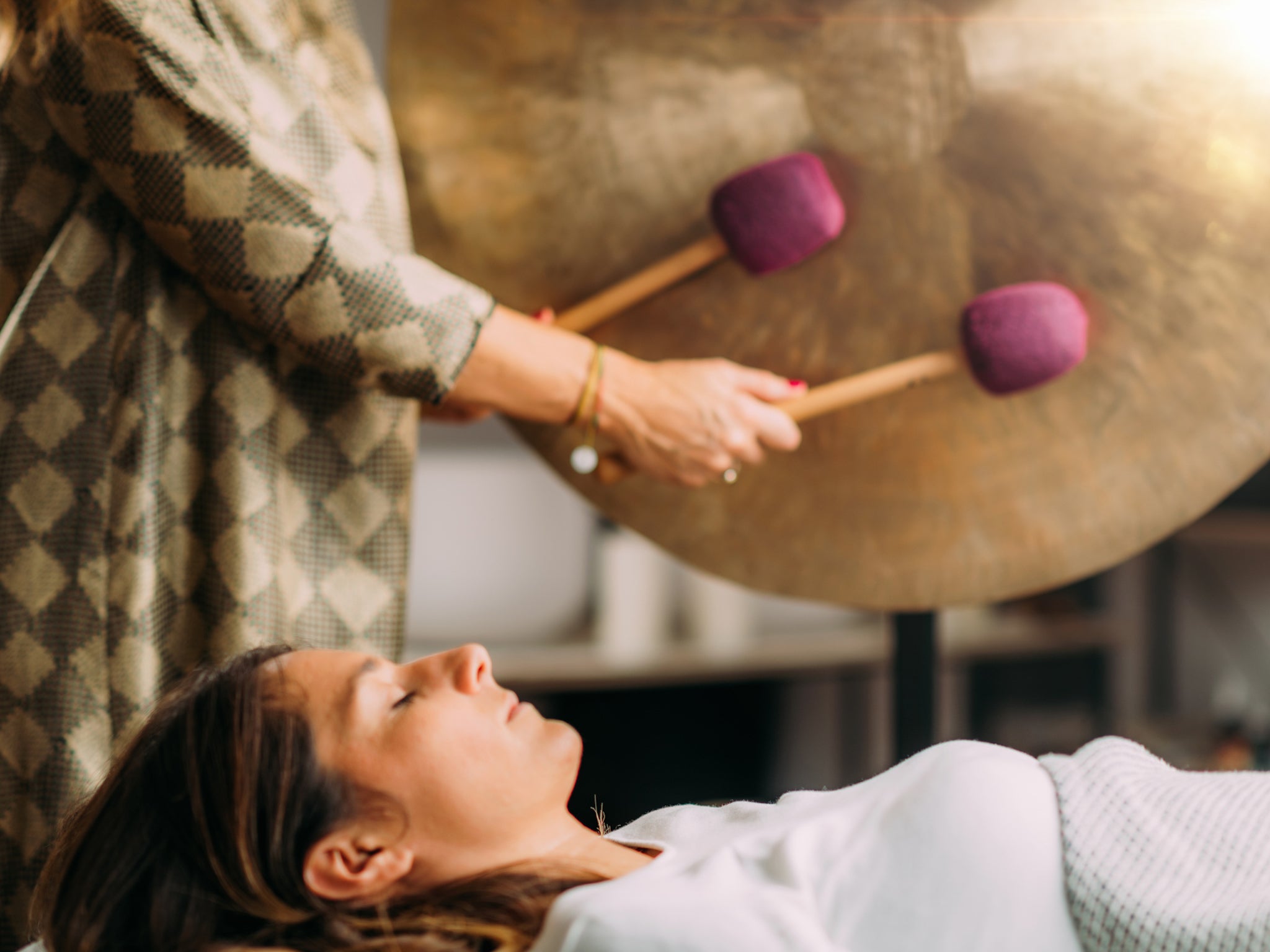
Though you might roll your eyes at the mere mention of “good vibrations” it’s more than a coincidence that music, religious reverence and healing have been interconnected throughout history. The vibration of a gong, a drum or the human voice chanting supposedly has a positive effect on our nervous systems and elicits a calm, reflective or even emotional state.
It certainly feels that way whenever I’m enveloped by a series of sustained vibrating tones at a sound bath – something I’ve been doing regularly for the past couple of years. At a sound bath, a practitioner usually plays singing bowls and gongs, and sometimes a collection of percussive instruments and chimes, to create a soundscape for approximately an hour. Often participants are invited to lie down and close their eyes and sometimes singing bowls are placed on different parts of the body.
However, sound healing isn’t limited to gong baths – it’s a therapeutic practice that uses vibration produced by instruments or voice to promote physical, emotional and mental wellbeing. This can mean listening to a sound bath, mantra or specific frequency on an app – I often use apps like The Yoga Class or Soaak for this – playing an instrument, or practicing japa meditation, a form of meditation paired with rhythmic chanting.
For me, these practices have been infinitely soothing and have helped me to calm my nerves, quell anxiety and enjoy the relaxing benefits of being submerged in sound. Apps, events and courses focused on the soothing power of sound have recently boomed in popularity, so I spoke with experts to find out why this might be and what the science behind sound healing shows.
What is sound healing?
Anne Malone, founder of Oasis of Sound and practitioner at Bhuti spa and health club tells me: “It's based on the idea that sound can influence our body's energy field, brainwave activity and cellular processes. Everything in the universe, including our bodies, vibrates at a specific frequency. Sound healing uses these vibrations to influence the body's energy and physiology.”
Though this may sound “woo” to some, sound healing has been utilised by cultures all over the world, from the ancients to the present day. It has its roots in Pythagoras’ “music of the spheres”, the Vedic traditions of India, Tibetan Buddhism, the shamanic practices of Mesoamerica and the continent of Africa.
“The vibrational qualities of the instruments are believed to promote energy balance and mental clarity. When an external sound frequency matches the natural frequency of an object or body part, it can cause it to vibrate more strongly. This is called resonance and can influence the body's cells and tissues,” explains Malone.
“Experiments show that sound frequencies can organise particles into complex patterns.T o demo this, I place water in a singing bowl, play the bowl and as the vibrations from the bowl contact the water, bubbles start to appear and the water takes on the appearance of boiling – the vibrations are dancing the molecular makeup of the water.
“I believe that similar principles might apply in the body, where sound could influence cellular organisation and communication. Sound, especially soothing music or harmonic tones, can stimulate the parasympathetic nervous system, which reduces cortisol levels. This stress-reducing effect can promote healing, both mentally and physically, by creating a state where the body can repair itself more effectively.” she adds.
Sound healing uses various tools specifically designed to produce tones, frequencies and vibrations that are believed to promote physical, emotional and energetic healing. Each tool interacts with the body and mind in unique ways, often targeting specific frequencies associated with different emotional states, or physiological responses.
The idea is that vibration has the power to stimulate the vagus nerve – the longest nerve in the body and a vital part of the nervous system that regulates myriad bodily processes. If you’ve ever felt relaxed while listening to a piece of music or felt the hairs rise on your arms hearing someone sing, that’s your nervous system reacting to the sound. Sound healing often induces a deep parasympathetic state – our rest and digest state – which contrasts sharply with the fast-paced, stress-heavy sympathetic – or fight or flight – state we usually find ourselves in.
“Firstly, it's important to remember that quite literally any behaviour changes brain states, because the brain state is what defines what you're thinking, feeling and doing,” says neuroscientist and founder of Samphire Neuroscience Dr Emilė Radytė.
“That being said, there does appear to be some early neuroscientific evidence that repetitive, predictable sound, at the core of sonic vibrations, can shift arousal and attention via auditory–thalamocortical pathways. Some early research has suggested that low tempos, drones, and steady rhythms might promote parasympathetic tilt (relaxation), and the brain could potentially show frequency-following/entrainment responses (ASSR/FFR) to certain pulse rates, though most research is still at an exploratory stage.”

Altered states
Sophie Hascher, a neuroscientist and the founder of BrainFlowElite explains that, “neuroscience also points to certain sound frequencies as particularly effective for relaxation, especially low-frequency delta (0.5–4 Hz) and theta (4–8 Hz) waves. When these are woven harmonically into music, the effects are even stronger. Studies show that combining monaural beats in these ranges with soothing pentatonic melodies can lower anxiety and lift mood far more than playing the beats alone.”
Malone agrees, explaining that, “certain sound frequencies can influence brainwave activity. For example, binaural beats (two slightly different frequencies played in each ear) can cause the brain to synchronise with the perceived third tone. This can help guide the brain into different states.”
Read more: What is contrast therapy and is this wellness trend safe for everyone?
“Feeling emotional or strange after sound healing is not only normal, it’s often a sign that something meaningful happened,” she adds. “You may have slowed down, retuned, possibly accessed and released deeply held tension or emotions.
“Vibrational frequencies, especially from instruments like singing bowls, gongs, or drums, can bypass the thinking mind and directly affect the limbic system – the emotional centre of the brain. This can bring unresolved feelings to the surface.You may cry, feel a sense of sadness, or experience joy without knowing exactly why. It’s often compared to the catharsis people feel after therapy or deep meditation. Certain frequencies can evoke memories or bodily sensations tied to past experiences. For example, a specific tone might remind your body or subconscious of a time you felt safe or unsafe, which can be emotionally triggering,” she adds.
Hascher also points to recent studies on music and neuroplasticity in humans which show that music doesn’t just change how we feel, but it can actually reshape the brain. “It influences neurotransmitters, strengthens neural connections and, in some cases, even boosts immune function. In critically ill patients, listening to calming music such as Mozart’s piano sonatas lowered stress hormones and improved recovery,” she notes.
What does the science say?
Several studies have shown that sound often induces theta or alpha brainwaves, the brainwaves associated with deep meditation, creativity and subconscious processing. We spend a lot of our time in beta so switching over whilst awake, especially if you aren’t someone who often meditates, can feel strange.
In a study conducted by Hascher and scientific advisor Melinda Palomino, Hascher noted, “our key finding was an increase in theta activity throughout the session. During the crescendo of the sound healing experience, we observed that the relative power of theta activity increased, commonly associated with deep relaxation and giving up of control”.
She explains that instruments such as gongs and Tibetan bowls which produce rich harmonic overtones naturally nudge the brain into slower, more restorative states. “When layered correctly, these tones mirror frequencies associated with deep rest and emotional processing, often triggering delta and theta states measurable by EEG. What feels like stillness is actually a recalibration of the nervous system,” says Hascher.
“As a neuroscientist, I’ve witnessed firsthand the power of music to shift mood and promote healing. Sound healing can be a great tool to release stress and calm down the nervous system and combining music with movement can genuinely transform both the mind and body, unlocking deep emotional release.”
However, Radytė explains that, “with all holistic methods, combination is usually more powerful than stand-alone approaches, which certainly holds for sound healing as well. From the limited data from research, it appears that outcomes primarily depend on dose, predictability, and agency of the user. [For example] making sure you're engaging with sound healing in a calm and controlled space, breathing slowly, having comfortable posture and clear opt-out cues (such as setting an alarm if you're staying alert and worried about drifting off).
“Neuroscientists should also acknowledge that while the evidence basis is still weak in modern and largely Western medicine, we must acknowledge the cultural origins of practices such as sound healing which have thousands of years of practice, with our clinical study methods and outcomes needing to catch up to build a stronger evidence base,” she adds.

Deeper healing through sound
Some practitioners argue that vibrations from sound can also help with physical healing by penetrating deep into muscles and tissues, helping to loosen tight fascia and relieve pain. More research is needed on this but there is some limited evidence to suggest that by relaxing the nervous system, chronic pain can be lessened and become more manageable.
Sound practitioner Ricci Gowland explains that, “the beauty of sound is that it bypasses our busy, thinking minds. The vibrations move through our bodies on a subconscious level, gently shifting energy and healing parts of the body we're not aware of, so sometimes the most profound shifts happen when we simply allow ourselves to receive and surrender.
“I often sing mantras at home when I’m feeling overwhelmed, or play certain frequencies, like solfeggio tones, to shift the energy in my space. Sometimes I’ll use them to help calm down my two boys with big energies or even while I sleep so that the healing vibrations are working in the background,” she says.
Singing, chanting and mantra-based meditation are intertwined with healing across myriad cultures. In the Vedic tradition, the “om” sound is considered to be an audible manifestation of the whole universe – the root vibration that moves through the entire body when said or sung aloud.
Sanskrit hymns and Gregorian chants supposedly make use of “healing frequencies” also known today as “Solfeggio frequencies”. These specific tones, identified by researchers in the seventies, can be found in all manner of spiritual music and in instruments that are considered sacred and healing, like Tibetan singing bowls, gongs and steel tongue drums. Some people believe the concept of Solfeggio tones to be pseudoscience due to a lack of specific studies and data, though the practice of sound healing itself and the tools used has been widely studied.
Read more: The best infrared sauna blankets for at-home self-care, chosen by our wellbeing editor
“The layering of instruments, the resonance of a shared field, and simply being held in the experience, creates an experience that’s hard to recreate on your own. The gong especially can be incredibly powerful but it can sometimes even bring up emotions or anxiety, which is why it’s important to be in a safe, guided space. The instruments themselves matter too. Good quality bowls, gongs, and chimes carry such pure, rich tones, and you can really feel the difference in how your body receives the vibrations,” says Gowland.
There is something to be said for experiencing a sound bath delivered by a professional in that it can feel so much more intense, uplifting and soothing than simply listening to binaural beats through headphones. Hascher explains that, “neuroimaging studies show that live music activates the brain’s emotional centre, like the amygdala, more strongly than recorded music. Live performances also create a stronger emotional connection in real time, syncing the music with listeners’ brain activity.”
So whilst a soothing playlist or recording of a gong bath might relax you, it seems live music and proximal vibration has a more powerful effect on the brain.
“I’ve definitely found, for me, that sound healing has helped reduce stress and anxiety. Many people also share that it improves their sleep, enhances focus and clarity, boosts creativity, and creates a simple, yet so powerful, sense of inner calmness. It’s not only a spiritual practice, but one that's practical in our health too.” Says Gowland, who hosts sound healing experiences in London and Ibiza. “I think people are craving ways to ground and regulate themselves in a world that feels so fast and overwhelming right now and we’re looking for the tools to guide us back into balance, harmony and health.”
Dr Radytė points out that there are very few risks associated with sound healing, “there has never been a documented case of any side effects linked with sound healing, and even if it may never have stand-alone benefits for health or medical conditions, it may still be effectively combined with other treatments, such as brain stimulation.”
She describes the new popularity and accessibility of sound healing tools, spaces and events as a “net positive” for stress relief and community. “It can bring people together, which is always great. However, from what I have seen, quality varies and marketing can oversell outcomes, leading to people delaying vital treatments. Minimum standards, such as sound level limits, practitioner training, and clear ‘wellness adjunct, not medical cure’ language would make these offerings safer and more credible in the long-term as they continue expanding.”
Read more: Sleepmaxxing: Is the pursuit of the perfect night’s rest making us more anxious?







